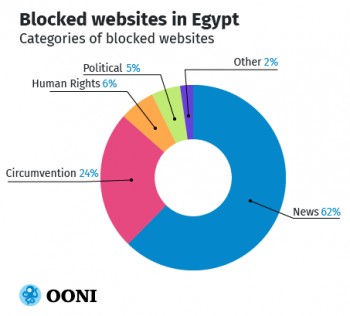This post and the full report have been published by OONI, a censorship measurement project under the Tor Project, and Egypt’s Association for Freedom of Thought and Expression (AFTE).
Throughout the testing period, between January 2017 to May 2018, more than 1,000 URLs presented network anomalies. 178 of which consistently presented a high ratio of HTTP failures, strongly suggesting that they were blocked. Rather than serving block pages (which would have provided a notification of the blocking), Egyptian Internet Service Providers (ISP) appear to primarily block sites through the use of Deep Packet Inspection (DPI) technology that resets connections.
In some cases, instead of RST injection, ISPs drop packets, suggesting a variance in filtering rules. In other cases, ISPs interfere with the SSL encrypted traffic between Cloudflare’s Point-of-Presence in Cairo and the backend servers of sites (psiphon.ca, purevpn.com and ultrasawt.com) hosted outside of Egypt. Latency measurements over the last year and a half also suggest that Egyptian ISPs may have changed their filtering equipment and/or techniques, since the latency-based detection of middleboxes has become more challenging.
 The chart at the right illustrates the types of sites that presented the highest amount of network anomalies and are therefore considered to more likely have been blocked.
The chart at the right illustrates the types of sites that presented the highest amount of network anomalies and are therefore considered to more likely have been blocked.
More than 100 URLs that belong to media organizations appear to have been blocked, even though Egyptian authorities only ordered the blocking of 21 news websites last year. These include Egyptian news outlets (such as Mada Masr, Almesryoon, Masr Al Arabia and Daily News Egypt), as well as international media sites (such as Al Jazeera and Huffington Post Arabic). Various Turkish and Iranian news websites were blocked (such as turkpress.co and alalam.ir), suggesting that politics and security concerns may have influenced censorship decisions. In an attempt to circumvent censorship, some Egyptian media organizations set up alternative domains, but (in a few cases) they got blocked as well.
To examine the impact of these censorship events, AFTE interviewed staff members working with some of the Egyptian media organizations whose websites got blocked. They reported that the censorship has had a severe impact on their work. In addition to not being able to publish and losing part of their audience, the censorship has also had a financial impact on their operations and deterred sources from reaching out to their journalists. A number of Egyptian media organizations have suspended their work entirely, as a result of persisting internet censorship.
Many other websites, beyond media, appear to have been blocked as well. These include human rights websites (such as Human Rights Watch, Reporters without Borders, the Arabic Network for Human Rights Information, the Egyptian Commission for Rights and Freedoms, and the Journalists Observatory against Torture) and sites expressing political criticism (such as the April 6 Youth Movement), raising the question of whether censorship decisions were politically motivated.
“Defense in depth” tactics for network filtering
Security experts are probably familiar with the “defense in depth” concept in which multiple layers of security controls (defense) are placed throughout an IT system, providing redundancy in the event that a security control fails. In Egypt, ISPs seem to apply “defense in depth” tactics for network filtering by creating multiple layers of censorship that make circumvention harder.
This is particularly evident when looking at the blocking of Egypt’s Freedom and Justice Party (FJP) site. Our testing shows that different versions of this site (http://www.fj-p.com and http://fj-p.com) were blocked by two different middleboxes. In doing so, Egyptian ISPs added extra layers of censorship, ensuring that circumvention requires extra effort.
Not only were numerous circumvention tool sites (including torproject.org and psiphon.ca) blocked, but access to the Tor network appears to be blocked as well. Measurements collected from Link Egypt (AS24863) and Telecom Egypt (AS8452) suggest that the Tor network is inaccessible, since the tests weren’t able to bootstrap connections to the Tor network within 300 seconds. In recent months, more than 460 measurements show connections to the Tor network failing consistently. Similarly, measurements collected from Etisalat Misr (AS36992), Mobinil (AS37069) and Vodafone (AS36935) indicate that access to the Tor network is blocked. The Tor bootstrap process is likely being disrupted via the blocking of requests to directory authorities.
“Defense in depth” tactics also seem to be applied in relation to the blocking of Tor bridges, which enable Tor censorship circumvention. Vodafone appears to be blocking obfs4 (shipped as part of Tor Browser), since all attempted connections were unsuccessful (though it remains unclear if private bridges work). All measurements collected from Telecom Egypt show that obfs4 works. Given that bridges.torproject.org is blocked, users can alternatively get Tor bridges by sending an email to [email protected] (from a Riseup, Gmail, or Yahoo account).
 Ad campaign
Ad campaign
Back in 2016, OONI uncovered that state-owned Telecom Egypt was using DPI (or similar networking equipment) to hijack users’ unencrypted HTTP connections and inject redirects to revenue-generating content, such as affiliate ads. The Citizen Lab expanded upon this research, identifying the use of Sandvine PacketLogic devices (Sandvine is a company based in Waterloo, Ontario, Canada) and redirects being injected by (at least) 17 Egyptian ISPs.
Over the last year, hundreds of OONI Probe network measurements (collected from multiple ASNs) show the hijacking of unencrypted HTTP connections and the injection of redirects to affiliate ads and cryptocurrency mining scripts. A wide range of different types of URLs were affected, including the sites of the Palestinian Prisoner Society and the Women’s Initiatives for Gender Justice, as well as LGBTQI, VPN and Israeli sites. Even the sites of the United Nations, such as un.org and ohchr.org, were among those affected by redirects to ads.
To learn more about this study, read the full report here.


